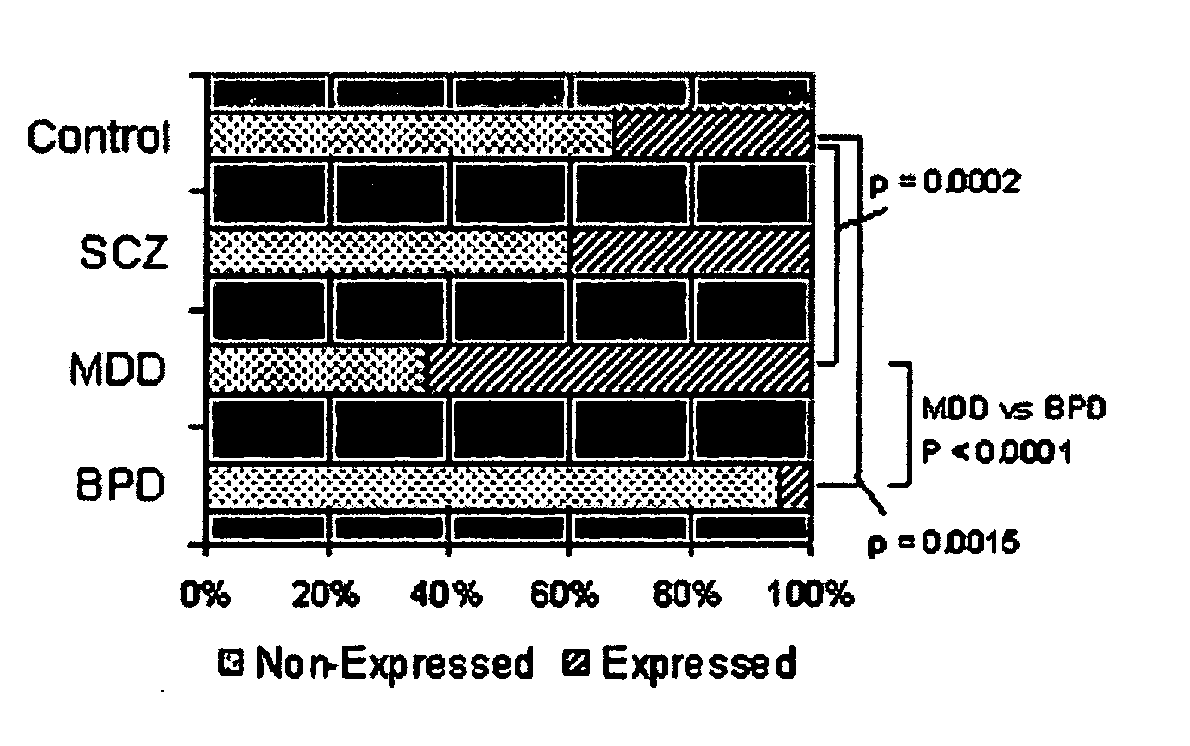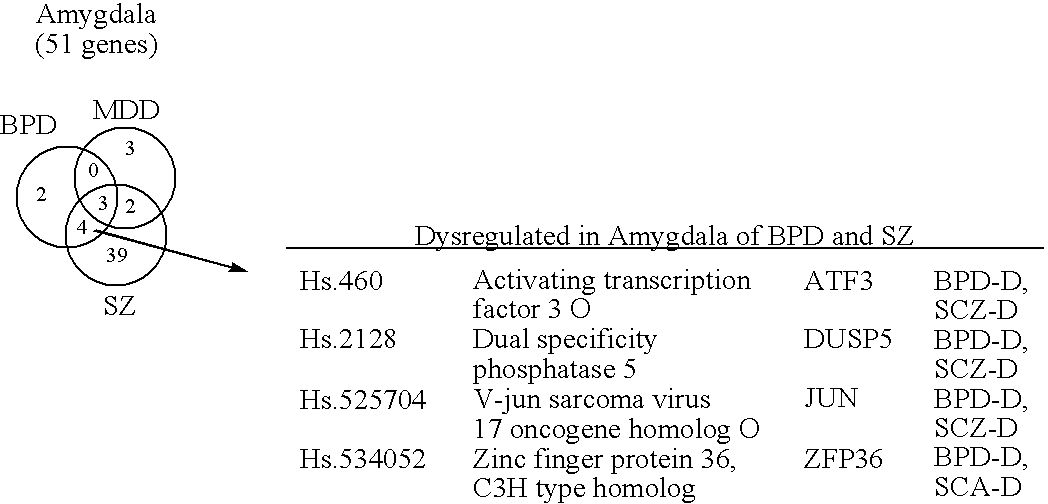Compositions and methods for diagnosing and treating neuropsychiatric disorders
a neuropsychiatric disorder and composition technology, applied in the field of compositions and methods for diagnosing and treating neuropsychiatric disorders, to achieve the effect of enhancing reducing the expression of polynucleotides
- Summary
- Abstract
- Description
- Claims
- Application Information
AI Technical Summary
Benefits of technology
Problems solved by technology
Method used
Image
Examples
example 1
Identification of Genes Dysregulated in Schizophrenic Patients
[0231] Post mortem mental disorder brains (i.e., from schizophrenia patients) and control brains were used in this study. Each brain pair (case and control) was matched on the basis of gender, age, and postmortem interval. The patient's particular conditions in their terminal phase (agonal factors, e.g., seizure, coma, hypoxia, dehydration, and pyrexia) and the conditions of the brain tissue after death (postmortem factors, e.g., postmortem interval, and freezer interval) are two major influences on RNA preservation in postmortem brain tissue. Brain pH has been evaluated as an indicator for agonal status, and as an indicator of RNA preservation. Subjects with agonal factors and low pH samples, in which RNA quality was found to be compromised were eliminated from the study.
[0232] In this study, dysregulation of gene expression was studied in six brain regions: the anterior cingulate cortex (AnCg), dorsolateral prefrontal...
example 2
Peripheral Biomarker Expression of Dysregulated Genes Found in Brain
[0237] For this study, a separate cohort of individuals with schizophrenia (n=5) were matched for gender and age to unaffected (n=5) members of a pedigree. Freshly isolated lymphocytes from each individual were transformed using the Epstein-Barr Virus and grown until confluent in RPMI-1640 media supplemented with 15% fetal bovine serum (heat-inactivated), 2 mM L-glutamine and 25 mg of gentamicin. RNA was extracted from ˜5×107 lymphoblastic cells using the standard TRIzol isolation protocol (Invitrogen, Carlsbad, Calif.). Affymetrix Human Genome U133A Arrays were used for gene expression according to the manufacturer's protocol. The gene expression traits were derived from the U133A chips and analyzed by robust multiarray condensation algorithm (RMA). Differential gene expression (gene expression trait for the purpose of this analysis) was defined as a gene that displayed a significant two-tailed t-test (p<0.05) in ...
example 3
Validation of PSPHL Insertion Deletion Mutation
[0241] The present invention extended the previous findings regarding the insertion-deletion polymorphism of phosphoserine phosphatase-like gene, and the association between deletion allele of PSPHL and susceptibility to bipolar disorder (BPD).
[0242] We previously determined 1) PSPHL gene consists of 4 exons. Exons 1, 2, 3 and 4 are 213 bp, 114 bp, 122 bp and 501 bp, in length, respectively, and span introns 1, 2 and 3 (3221 bp, 829 bp and 11939 bp, in length, respectively). 2) PSPHL and PSPH are highly homologous, which locate 200 kb apart from each other on chromosome 7p 11.2 region. 3) PSPHL gene has two alternative transcripts, one of which utilizes the exons 1-4 (PSPHL-A), while another utilizes the exons 1, 2 and 4 (PSPHL-B). Predicted proteins of PSPHL-A and PSPHL-B share N-terminal 57 common amino acids, transcribed from exons 1 and 2. PSPH and the predicted PSPHL-A&B have 31 amino acids in common. 4) There locates an insertio...
PUM
| Property | Measurement | Unit |
|---|---|---|
| Time | aaaaa | aaaaa |
| Time | aaaaa | aaaaa |
| Time | aaaaa | aaaaa |
Abstract
Description
Claims
Application Information
 Login to View More
Login to View More - R&D
- Intellectual Property
- Life Sciences
- Materials
- Tech Scout
- Unparalleled Data Quality
- Higher Quality Content
- 60% Fewer Hallucinations
Browse by: Latest US Patents, China's latest patents, Technical Efficacy Thesaurus, Application Domain, Technology Topic, Popular Technical Reports.
© 2025 PatSnap. All rights reserved.Legal|Privacy policy|Modern Slavery Act Transparency Statement|Sitemap|About US| Contact US: help@patsnap.com



